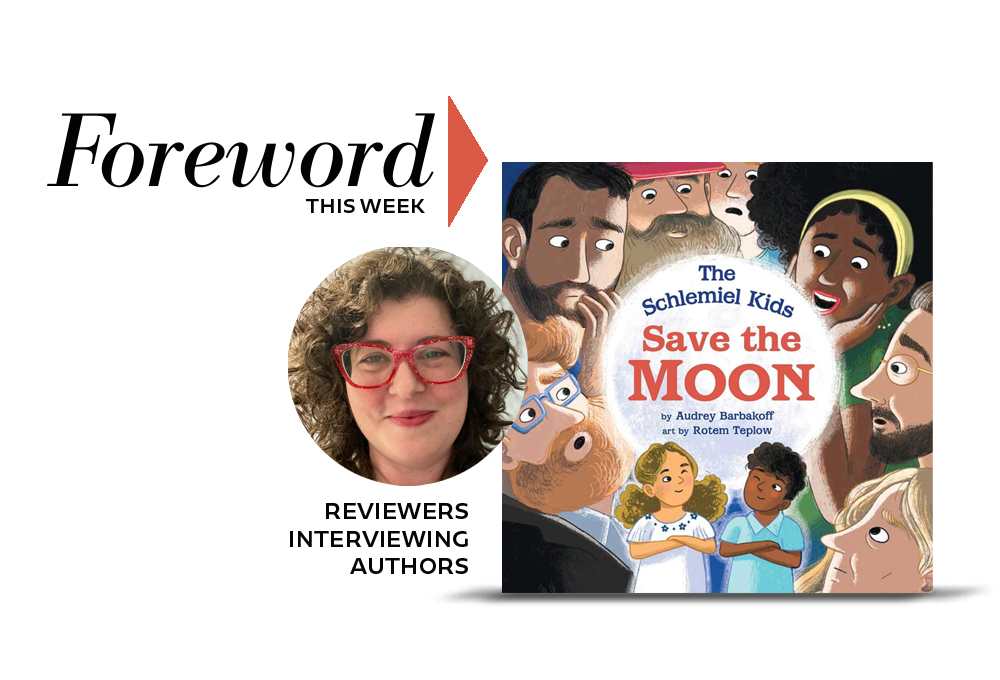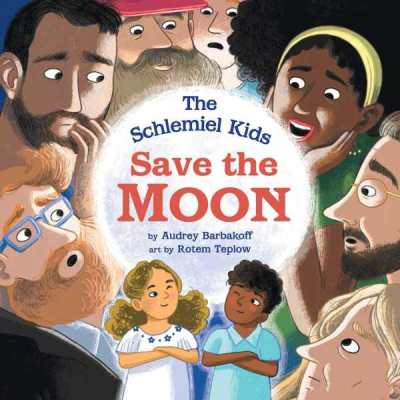Interview with Audrey Barbakoff and Rotem Teplow, Author and Illustrator of The Schlemiel Kids Save the Moon


A recent Pew study found that a third of Jews younger than forty don’t think of Judaism as their religion as much as they view it as their ancestry or identity. That identity may include adhering to a few Jewish rituals and observances, but for many younger Jews it’s the same motivation that drives spiritual seekers from all walks of life to adopt practices and beliefs from various sources, whether Buddhist, Jewish, pagan, or otherwise—sampling and searching for that certain something that seems to be missing from a life lived outside of religion.

Of course, this a la carte approach is rejected by most Orthodox Jews. To them, one of Judaism’s greatest strengths and appeals is its adherence to the same set of beliefs for nearly four thousand years.
For Jews, these are complicated times, but as much as the world changes, a truly remarkable faith offers each of them peace and the promise of a bright future.
Check out Editor-in-Chief Michelle Anne Schingler’s lovely review of Audre Barbakoff’s The Schlemiel Kids Save the Moon, and then enjoy the following conversation.
In your play on the stories of Chelm, it’s the children who are the town’s wisest souls—and they are actually wise, in comparison to the adults’ more bumbling “wisdom.” What inspired this reversal?
Audrey: As a Jewish mom and librarian, I love sharing stories with my children. I started looking for some Chelm tales to read with them, since I’d loved those as a kid. But I kept setting them aside because the humor depended on adults and their problems, which wouldn’t mean much to my very young sons. That made me wonder—where were the kids of Chelm? And then it hit me. What if the children were smart? Considering how many ways my four-year-old has found to convince us to delay bedtime, it wasn’t such a stretch to imagine kids cleverer than a whole town of grown-ups!
That question stuck with me until it started to unfold into a story of its own. I realized that retelling the original tales through the eyes of some very clever children in a modern-day Chelm could add a whole new layer of meaning and humor. Kids know they are smarter than grown-ups usually give them credit for! So, I wrote protagonists Sam and Sarah as a way for young readers to put themselves into the story. And while kids will still giggle at the antics of the not-so-wise adults, they can laugh even harder with the added glee of outsmarting them too.
The residents of Chelm prove very good about working together to find a solution to what most of them agree is a problem; they’re less adept at listening to the children’s voices, though. Still, the children persist! What can audiences learn from the townfolk’s interpersonal dynamics?
Audrey: Every child knows what it feels like to struggle to get adults to listen and take them seriously. I think this is one of the greatest frustrations of childhood. Reading about kids who cope with that situation and come out on top is validating, maybe even a little cathartic. That’s a big part of the humor and joy of The Schlemiel Kids. As adults, we need to remember that children have real knowledge, opinions, and perspectives. Children deserve to be heard. They may interpret a situation differently than adults, but that can sometimes be a very good thing—especially in Chelm!
As for working together, it’s true that the adults come to consensus on both the problem and the solution. There’s just one teeny-tiny issue: they’re completely wrong. That’s because they aren’t truly collaborating so much as they are panicking into groupthink, jumping on the bandwagon with even the most preposterous idea as long as the speaker sounds confident. Especially when juxtaposed with Sam and Sarah’s calm thoughtfulness, the townfolks’ actions can remind us that there’s a balance between listening to others and thinking for yourself. What’s popular isn’t always what’s right, and authority isn’t the same as wisdom.
Rotem, your Jewish cast is quite diverse, including Sam and Sarah’s own family. How reflective is this of the Jewish communities that you’ve grown up in and lived among, and what do you hope audiences take away from this portrayal?
Rotem Teplow: In Israel, the community is extremely diverse and includes people of different colors and cultures. There is a lot of beauty in this, and the unique customs, diverse foods, and distinctive character of each community create a diverse, interesting, and beautiful society. All the different shades in Israeli-Jewish society, of which I am a part, represent its uniqueness and beauty. That’s what I hope the audience will take away from the illustrations of the book: the ethnic and cultural diversity of the characters.
Audrey: I’d love to add to Rotem’s response. It was incredibly important to me that our modern-day Chelm would reflect the rich diversity of the Jewish community. I pictured Sam and Sarah as multiracial from the very beginning. In the US, where a lot of Jews are descended from Eastern European and Soviet refugees, I often notice a misconception that Jews are ethnically, racially, and culturally monolithic. It is so important that we never erase Jews of color, at home or globally. Jews come in every color and shape. We are as diverse as the world we live in. And that is always worth celebrating!
Audrey, you make generous use of Yiddish in your story. Can you speak a bit about why you intermingled two languages, and about the significance of the Yiddish terms to the tale?
Audrey: I grew up hearing the adults in my life sprinkle Yiddish throughout their conversations. (Especially when my grandparents wanted to say something rude!) The vocabulary and speech patterns of Yiddish are deeply woven into the texture of my family memories and stories. Yiddish is part of our heritage. It’s the flavor of our discourse and our humor, even though very few of us speak it fluently anymore. I don’t want my kids and their generation to lose this part of their culture. I’ve been so happy to see a bit of a Yiddish revival in theatre and popular culture lately, and I’d like to think my book contributes to that movement in a small way.
Diaspora Jewish languages like Yiddish, as well as Ladino and many others, map the history of who we are and where we’ve been as a people. They evolved as Jewish communities integrated into new places while holding onto our unique identity. Today, more than ever, we need to remember how to maintain that balance. Keeping our languages alive, even in small ways, is an act of celebrating survival, de-assimilation, and resistance.
Plus, Yiddish is just plain fun! It’s a very expressive language. Try to keep your face straight and your hands still as you say you’re “verklempt” or “kvelling” or “schvitzing”—I don’t think it’s possible! You can also pack a lot of shades of meaning into the way you say a word, which is great for humor. In short, a large part of why I pepper Yiddish into my writing is because I like it. It’s a pleasure to share some joyfully juicy Yiddish!
Audrey and Rotem, what are your hopes for the Schlemiel kids’ entrance into the broader reading world?
Audrey: I hope that kids of all backgrounds laugh themselves silly! While the Chelm stories come from Ashkenazi Jewish tradition, I wrote this book to be funny and relatable to anyone. Referencing Rudine Simms Bishop, books can be windows, mirrors, and sliding glass doors. I hope Jewish kids see themselves reflected in a story where their identity is fun and worth celebrating. I hope non-Jewish kids get a peek into the richness and joy of Jewish culture beyond the Holocaust and Hanukkah. And I hope that kids of all backgrounds enjoy jumping into a silly story. Plus, since I’m a former children’s librarian who has led many story times, I also want librarians, teachers, and parents to have fun reading the book out loud with their kids!
Rotem: I feel connected to what Audrey wrote. Like her, I hope children will find moments of laughter and humor in the book. My son laughed out loud when I read him the story and gained strength from the fact that children are wise and can be correct. There is great comfort in that for a child, who are often suggested to accept adult choices or thought processes without question. I hope this encourages children to speak up, to think for themselves, to question, and, most importantly, to believe in their ability to solve the problems they encounter along the way.
Are there more Schlemiel kids stories to come?
Audrey: Well, there are still a lot more of the original Chelm stories for Sam and Sarah to explore! I do have another idea in the works, but I’m not ready to share it quite yet. If you want to be the first to hear about the next adventure, sign up for my email list at barbakoffbooks.com.
Michelle Anne Schingler
